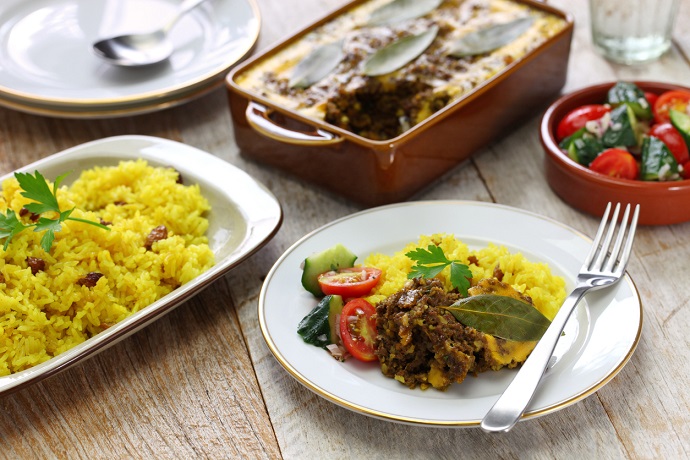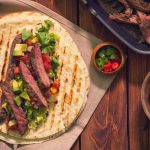To describe Africa's flavors and staple dishes in a sweeping statement is like trying to explain the culinary traditions of the entirety of North America. Because Africa is made up of many countries – each with distinct food staples and outside culinary influences – it's easier to introduce the cuisine regionally.
North Africa
North Africa's climate is as varied as its terrain, encompassing the Sahara Desert, the Atlas Mountains, and the Nile River. Because of its geographical location, many of the traditional dishes in this region share similarities with Mediterranean cuisine. Couscous, lentils, hummus, olives, mint, flatbread, yogurt, lamb, and fish are staples in the north.
Egypt, Libya, Tunisia, and Morocco are some of the countries in North Africa, and grilled vegetables, tagines or spice-laden stews, spicy fish dishes, and confections drizzled with honey and syrup are common. Olive oil, lemons, and garlic also feature heavily in North African fare.
West Africa
Another region with diverse terrain types, West Africa boasts a coastline with some of the best surfing on the continent, swaths of lush forests, and the hot, dry plains of the Sahara. Everyday food staples include yams, corn, cassava, rice, pumpkin, eggplant, okra, garlic, and tomatoes.
West African cuisine maintains its Moorish influence, so you'll find many of the same flavors and staples as North Africa. Spicy stews, jollof rice, and hearty cereal grains are common among West African countries, although the spices are more muted than the dishes of the North. While the French have their mirepoix and the Cajun and Creole have the holy trinity, the preferred West African aromatic base consists of tomatoes, onions, and chile peppers.
Central Africa
Arid desert, tropical rain forests, and mountains dot the geography of Central Africa, which is home to one of the world's wettest countries – Cameroon – and the Congo River. Meats such as goat and chicken provide protein and are served with sauces or in stews – simple cuisine marks this region. Whereas rice and couscous provide a starch component in other African regions, the central part of the country uses potatoes, yams, cassava, and plantains.
East Africa
Mount Kilimanjaro and Mount Kenya, along with valleys, lakes, and the Serengeti Plain, make up East Africa. East African cuisine is influenced by trade and colonization, with staples and spices from Portugal and India playing heavily into the food. You'll find flatbread, tomato dishes, grilled meats, and coffee in East Africa, along with chai tea, compliments of India.
Southern Africa
Coastline, mountains, and grassy plains make up Southern Africa, with a temperate, seasonal climate perfect for growing plentiful crops. Dried and spiced cured meats, dried, spiced sausage, dried fish, sweet, fried dough, porridge, yams, eggplant, and corn are popular food staples in the southern portion of the continent.
While this only scratches the surface of the rich culinary traditions found across Africa, it's easy to see how climate, terrain, trade, and colonization influence the foods and spices in each region.
Fun Fact: Peanuts, while primarily associated with South America, are prevalent in African cuisine and are found in everything from sauces to stews.
Sample two popular African dishes – Bobotie and Jollof Rice – at home, following the recipes below. Bobotie is a South African curried beef casserole, and jollof rice is a fragrant West African rice traditionally cooked over a wood fire, adding a rich, smoky flavor.
Bobotie
Servings: 12
3 tablespoons salted butter 4 eggs
1 ½ cups onions, finely diced 2 Granny Smith apples, peeled, cored, and diced
2 teaspoons fresh garlic, minced ⅓ cup dried apricots, julienned
1 tablespoon, ¼ teaspoon curry powder ⅓ cup seedless raisins
1 ⅛ teaspoons ground turmeric 1 lemon
2 bay leaves 1 ⅛ teaspoons ground black pepper
2 ½ pounds 90% lean ground beef ¼ teaspoon salt
2 ½ slices white bread, crumbled pan spray
1 ½ cups 2% milk, divided ½ teaspoon salt
STEP 1: Preheat oven to 325°F. Zest and juice lemon. Spray casserole dish with pan spray and set aside.
STEP 2: Melt butter in a saucepan. Add onions and garlic and sauté until translucent.
STEP 3. Stir in curry powder, turmeric, and bay leaves and cook briefly until fragrant. Remove pan from heat and remove bay leaves.
STEP 4: In a bowl, combine beef, breadcrumbs, ⅜ cup of milk, 1 egg, apricots, raisins, lemon juice and zest, pepper, and ¼ teaspoon of salt. Place mixture into a casserole dish and level with a spatula. Cover with foil and bake for 1 hour and 15 minutes.
STEP 5: Increase over temperature to 400°F.
STEP 6: In a small bowl, combine remaining milk, eggs, and ½ teaspoon of salt. Remove casserole from the oven and pour the milk mixture on top. Return to oven and bake, uncovered, for another 15 minutes or until lightly browned.
Jollof Rice
Servings: 6
2 plum tomatoes, rough chopped 1 ⅓ cups dry, long-grain white rice
2 ½ tablespoons, 1 teaspoon vegetable oil 1 tablespoon fresh thyme, picked and chopped
⅓ cup yellow onion, finely diced ½ teaspoon kosher salt
2 ¾ cups water ⅛ teaspoon ground black pepper
STEP 1: Preheat oven to 350°F.
STEP 2: Place tomatoes in a food processor and puree until smooth.
STEP 3: Heat oil in a heavy bottom, oven-safe pot over medium-high heat. Add onions and sauté until translucent. Add tomatoes and cook until the mixture thickens.
STEP 4: Add remaining ingredients, mix well, and bring to a boil.
STEP 5: Remove from heat, cover, and bake in the oven for 30 minutes.
STEP 6: Remove from oven and let rest for 10 minutes before fluffing with a fork and serving.







